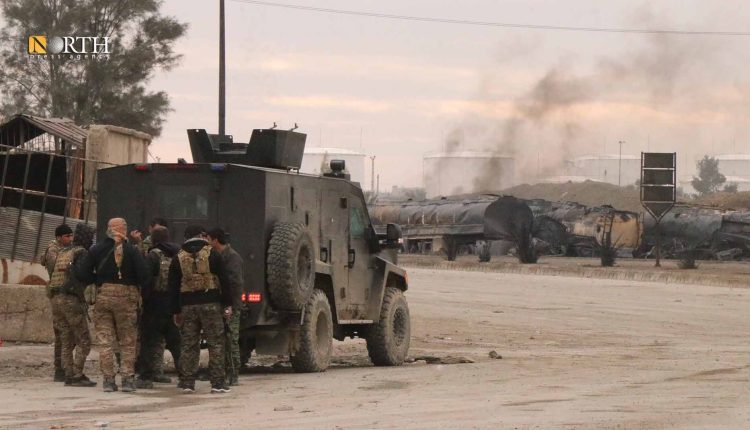
By Lamar Erkndi
The Al-Hol camp, situated on the outskirts of Al-Hol town, east of Hasakah in northeastern Syria, continues to alarm neighboring countries and governments worldwide, from where thousands of jihadists—both men and women—joined the Islamic State (ISIS), one of the most brutal terrorist organizations in modern history. Equally concerning are the prisons managed by the Syrian Democratic Forces (SDF), which hold at least 10,000 of the most dangerous ISIS fighters, notorious for their lethality among jihadist groups that have emerged in recent years.
ISIS has intensified its propaganda through social media, releasing audio and visual statements vowing to liberate its detained fighters and their families from Al-Hol camp. At its peak in 2019, following the collapse of the so-called Caliphate, the camp housed at least 70,000 people, over half of whom were children. This has prompted terrorism experts to pose a critical question: Is ISIS prioritizing attacks on prisons or camps in northern Syria?
ISIS’s Primary Objective
According to Rana Al-Ahmadi, a journalist specializing in jihadist groups, freeing detained members is at the forefront of ISIS’s agenda. In an interview with North Press, she explained that the group has meticulously planned operations targeting multiple prisons in northeastern Syria over the years. The 2021 assault on the Industrial Prison in Hasakah was the most significant, escalating into fierce battles inside and around the facility. Exclusive sources indicate that Uyghur jihadists were among the participants, with several killed by the SDF’s counter-terrorism units.
Al-Ahmadi highlighted the repeated failures of ISIS cells to secure the release of detainees from SDF prisons. “Yet, the group’s ambitions to free its fighters persist,” she said. “It has attempted similar operations in Raqqa and other areas. Despite issuing optimistic promises to storm Al-Hol and liberate its women and children, ISIS has not launched operations against the camps on the scale of the Industrial Prison attack.”
A Reservoir for Recruitment
The Al-Hol camp’s history traces back nearly a decade, coinciding with ISIS’s territorial expansion across Iraq and Syria, marked by executions, abductions, imprisonment, and widespread terror against local populations. The camp was reopened to shelter displaced individuals and victims of ISIS’s atrocities.
Following the group’s defeat in 2019 and the dismantling of its “Caliphate,” Al-Hol and other SDF-controlled camps became home to families of ISIS fighters—either killed in combat or detained, leaving their relatives behind. The extremist organization had attracted large numbers of recruits from diverse nationalities to its self-proclaimed state.
At its height in 2019, Al-Hol housed 75,000 people from 48 countries. Today, the population stands at approximately 50,000, with 90% being women and children. This includes 25,000 Iraqis, 18,000 Syrians, and 8,000 individuals from other nationalities. The age distribution is stark: 23% are under five years old, and 42% are aged 5 to 18, according to Tareq Abu Al-Saad, a researcher on international terrorism and political Islam, in a statement to North Press.
Abu Al-Saad emphasized that “ISIS’s primary gain from Al-Hol is the vast human reservoir provided by its families and residents, offering significant recruitment potential for highly capable cells. This generation could spawn organizations and groups even more violent and terrorist than ISIS.”
He warned that without intervention from the governments of countries from which these jihadists originated, alongside the international community, these individuals could be exploited by global organized crime and violence networks. A strategic approach to dismantling these camps is essential, he argued.
“Breeding a New Generation”
Egyptian journalist Adeeb Moner, an expert on terrorist groups and political Islam, described Al-Hol as a hub for dormant ISIS cells and a critical center for recruiting women and children. Speaking to North Press, he alleged that “ISIS women, through coercion or inducement, engage in illicit relationships with male children to produce a new generation of potential terrorists, laying the groundwork for future extremism in the camp.”
Abu Al-Saad suggested that ISIS leaders aim to extract their women and children—many of whom are now young adults—or smuggle fighters from Al-Hol to establish a new operational base amid Syria’s ongoing security and military instability.
Challenges Facing ISIS
Moner outlined several obstacles hindering ISIS’s plans for large-scale attacks on camps. “The group lacks safe havens for these families,” he said. “Operating covertly, ISIS controls no territory where it can secure borders. Protecting families would require a stationary force, limiting the group’s mobility, as it relies on rapid hit-and-run tactics. Moreover, relocating large numbers of families risks exposing them to strikes by the international coalition.”
He added, “The substantial funding needed to support these families is beyond ISIS’s capacity in its weakened state post-Caliphate. Consequently, the goal of liberating the camps has likely been deferred or abandoned, despite the group’s rhetoric.”
Rana Al-Ahmadi, who previously collaborated with international organizations operating in Al-Hol, raised another perspective: Has ISIS exploited images of its women and children in the camp to manipulate global supporters’ emotions, thereby securing funding? She believes, “ISIS has capitalized on portraying its children and women as deprived of basic necessities, eliciting sympathy from supporters abroad and amassing significant donations—a key component of its self-financing strategy.”
These funds, she noted, are used to pay operatives’ salaries and execute operations.
Moner corroborated this, stating that Al-Hol residents, particularly ISIS families, received financial transfers from abroad, notably Turkey. “The rapid and substantial flow of money into Al-Hol enabled ISIS to accumulate vast sums, which it used to conduct terrorist operations within the camp through active and dormant cells,” he said. “Neighboring countries also profited by facilitating financial support to the camp through intermediary companies.”
The SDF has conducted multiple security operations to disarm camp residents, confiscating various weapons and ammunition. These efforts have temporarily delayed the “detonation” of Al-Hol’s volatile situation, observers say, but the camp remains a ticking time bomb.
Despite shifts in Syria’s security and military dynamics, including the rise of new leadership, the “latent threat” posed by Al-Hol persists, as repeatedly warned by global powers, neighboring states, and analysts, according to reports.
